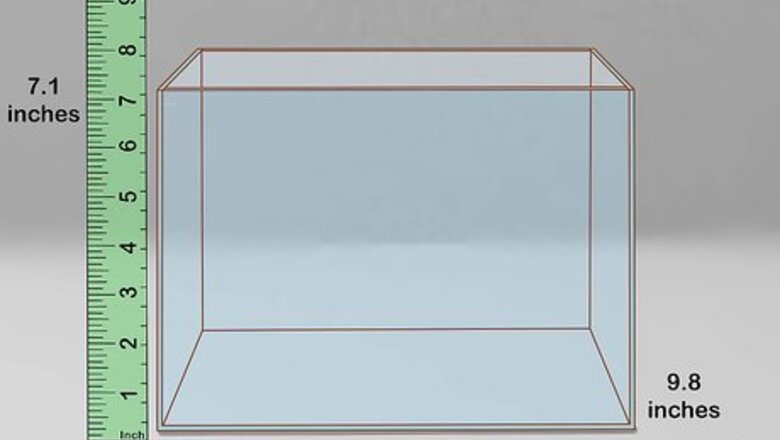
views
Setting Up The Enclosure and Substrate
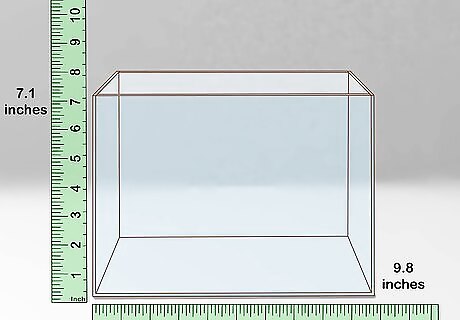
Pick a glass or plastic tank to house your snails in. The tank should be at least 18 cm (7.1 in) high and 25 cm (9.8 in) long. Choose a plastic or glass enclosure with a removable lid instead of a cage or open container as this will keep the soil moist and reduce the chance that your snails could escape. Snails prefer cool, dark environments, so keep the tank in a place out of direct light. Placing the tank away from sunlight helps to maintain the temperature of the habitat and prevents your snails from getting too hot, becoming dry or dehydrated, and dying.
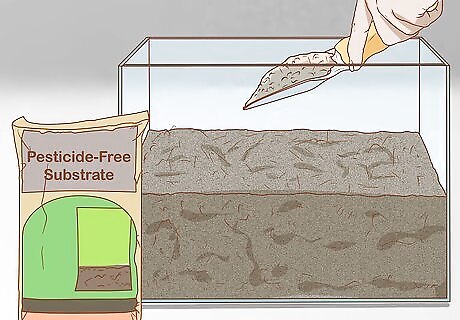
Add a 8 cm (3.1 in) deep layer of pesticide-free substrate. Compost from a garden center works well, but check the pH level of the compost and make sure there are no added chemicals that could hurt your snail. Layer the substrate in the bottom of the tank about 8 cm (3.1 in) deep and moisten it with a water spray bottle. If you plan on adding live plants to your tank, you will need to make the substrate a little deeper. Check the requirements for your plants to ensure you provide enough room to root and flourish. If you plan on using soil from your garden, leave the soil in the fridge or freezer overnight to kill any small organisms in the dirt.
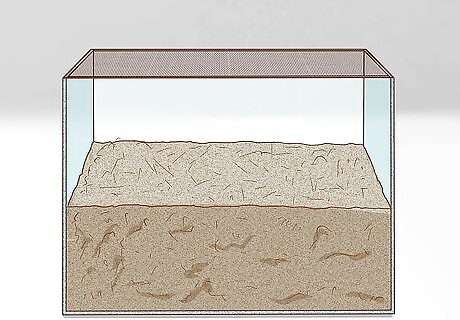
Cover the tank with a ventilated lid. The lid for the tank should have at least a few holes for ventilating new air in and out. If it doesn't, carve out a "window" in the lid carefully. Cover the ventilation holes with mosquito netting to stop outside bugs from entering the tank and to stop your snails from escaping. Some lids will come with holes already cut out, in which case you just need to worry about laying netting over them.
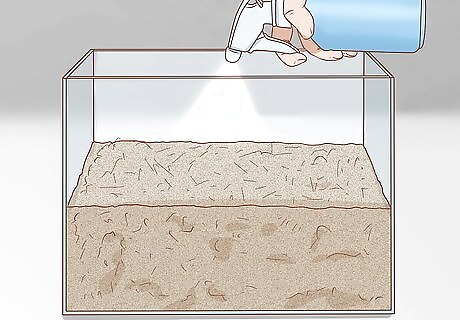
Moisten the soil so it is damp but not soaked. The soil should not be mushy and muddy, nor should it be dry and uninhabitable. Spray some water over the soil so that it feels soft to the touch but doesn't feel dripping wet. You should spray water regularly in the tank to maintain the humidity level. Over time, if the tank feels too damp, consider adding more ventilation holes to the top lid. If the tank feels too dry over time, you may need to moisten it more often than once or twice a day to maintain the environment's humidity. A large hole is preferable to small holes as more air will ventilate in and out, and as long as it's covered by netting your snails won't be able to escape.
Adding Decorations, Plants, and Organisms
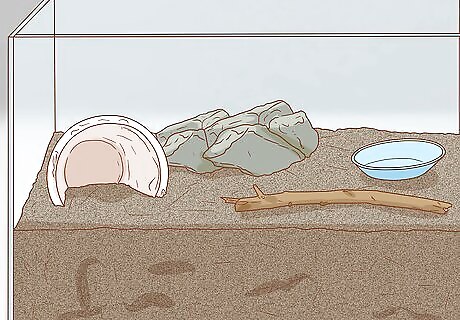
Collect some garden-themed decorations for your tank. There is a huge range of items you can add to your tank to make it look natural and aesthetically pleasing. The only things you should avoid are items that might raise the pH of the soil, such as painted pots, or water bowls, as snails do not need a dish to get water and may drown in the bowl. Some suggestions for decorations to add to the snail habitat include: Plain ceramics or unpainted pottery for your snail to use as a home Various sizes of rocks for your snail to hide amongst Bark and branches for your snail to climb up high Small statuettes to add scenery and aesthetic to the tank A broken plate or small dish to put your snail's food on
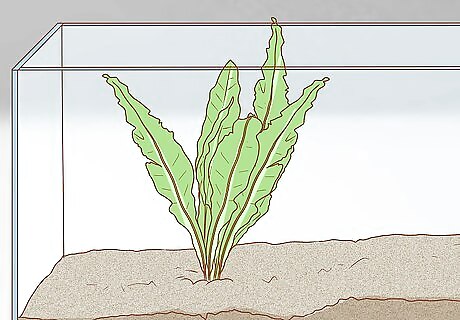
Plant live plants to make the habitat look natural. You can leave these plants in pots, or you can plant them directly in the soil. Low light plants are often best for indoor setups as they generally take to the soil well and thrive in the same conditions as snails do. Be aware that your snails may eat these plants and you may have to replace them after a while. Some suggestions for live plants to add to the habitat include: Ferns, which snails will usually avoid and thrive in low-light environments Ivy, which grows quickly and is generally avoided by snails Moss, which adds a bed of green to the soil and provides something for your snail to munch on Grasses, which create green patches for your snail to eat as a snack

Introduce supporting organisms such as pill bugs and earthworms. In addition to making the habitat feel and look more natural, other organisms such as earthworms, pill bugs, and woodlice will clean and maintain the soil. Earthworms break down the soil, pill bugs will break down excrement and leftovers, while woodlice will break down bark and natural additions to the tank to enrich the soil. While earthworms, pill bugs, and woodlice are specifically good for the tank, just about any small bug can be added to the tank, and are easily found in your back garden or your local natural area. While you don't have to add other bugs, you will significantly cut down the chances of developing mold in the tank as they serve as natural barriers against fungi.
Maintaining the Habitat
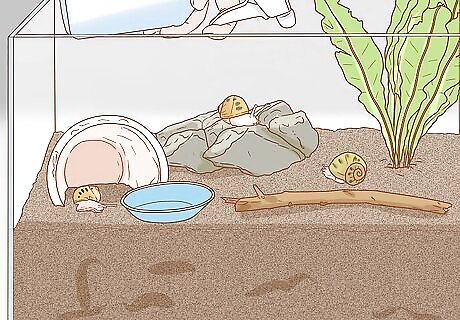
Regularly mist the tank with water to maintain the humidity levels. Snails prefer damp places and will stay in their shells if the environment is too dry. Water your plants when they need to be watered, but take care not to over-soak the soil. You should aim to re-spray the habitat every couple days, but don't spray if the soil still feels moist and damp. Don't use a spray bottle that was used for chemicals, instead opt to buy a new spray bottle to protect your snails from harmful contaminants. If you have decomposer species in the tank, they may drown if you overwater and the tank remains permanently soggy.
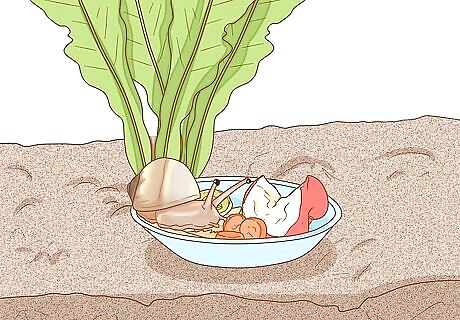
Feed your snails an assortment of vegetable and fruit scraps, but avoid citrus. Cabbage and green lettuce are good options, and fruit and veggie scraps from cooking are perfect to use as food instead of throwing them in the trash. Do not give your snails citrus as they react negatively to it, instead opt for non-citrus fruits like apples, bananas, and melon. Add some ground up cuttlefish bone to the habitat to give your snail a source of calcium. You can buy this in the bird section of your local pet store. If the food is uneaten after a few days, remove it from the habitat and try something else. Snails can be picky eaters, so it may take some trial and error to find something your snail likes to eat regularly.
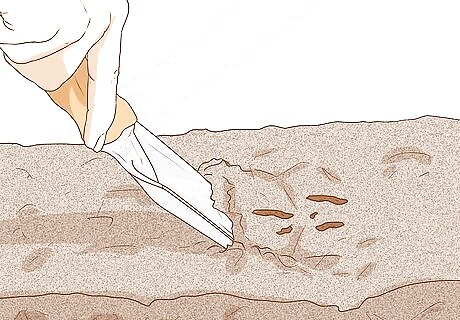
Clean up your snails' waste with gloves and a small trowel every day. There will be some waste that is not broken down, especially if you don't have support organisms in your tank. Regularly remove this waste to prevent your tank from smelling or looking dirty. Wear gloves when handling this waste and use a small trowel to avoid having to make contact with it at all.
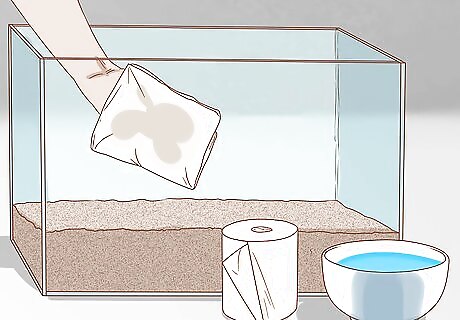
Wipe down the sides of the habitat with plain water once a week. The sides of the tank may start to build up snail waste and slime as your snails explore and climb around. Simply wet a rag with regular water and wipe down the sides of the tank once a week to reduce this build-up. Do not use chemicals, as all forms of chemical cleaner are toxic to snails.
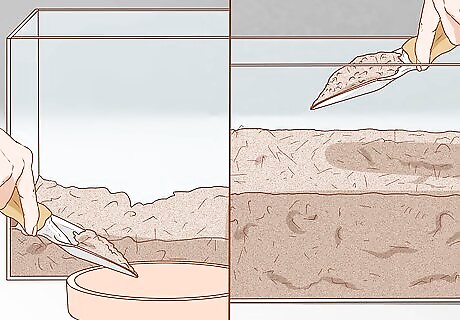
Replace the substrate if the soil is over-soaked or becoming moldy. Usually, you won't have to replace the substrate at all as the snails and other organisms in the soil will naturally regulate and maintain its health. If the soil starts to look moldy or is far too wet and puddle-like, remove the snails and all other organisms from the habitat gently — you may need to use a net for pill bugs and woodlice — then place them into a small container with some dirt while you replace the substrate. You won't have to do this very often if you have other organisms maintaining the soil. Check on the soil a few times each week to make sure it seems healthy and to make sure it seems hydrated.



















Comments
0 comment